
HISTORY OF SUISSE-ATLANTIQUE SA LAUSANNE / MORGES

1. Overview of the company history
This history started already before the outbreak of World War II, when two Swiss business men in Buenos Aires, Eric Demaurex and Georges Pasche (both relatives of the André family), back in 1939 purchased on behalf of Georges A. André the modern steamer ST-CERGUE (ex Felldene) and registered her under the flag of Panama. The ship was operated by the grain trading company André & Cie. S.A. Lausanne, Switzerland.
When Greece was occupied by the axis powers in early 1941, Great Britain blocked the Straits of Gibraltar. The Greek vessels chartered by the KTA, Bern (war transport office) now could not enter, nor leave the Mediterranean Sea. The federal government in Bern passed a maritime law in extremely short time, coming into force on 09.04.1941. Subsequently the Swiss flag was hoisted for the first time on 19.04.1941 on the CALANDA*), thus marking the foundation of the Swiss flag at sea.
As a consequence of this decree, Suisse-Atlantique Société d'Armement Maritime (first telegram address SUISARM) was established on 10.07.1941 and today is the oldest shipping company of Switzerland, has survived all the other old companies and is still successfully in business today. Next year, in 2016 the company will celebrate its 75th. anniversary.
The beginnings of the family enterprise André goes back to the first half of the 19th. century, when Henri I. André (1826 - 1901) born in the village of St-Cergue in the Vaud Jura, operated a small firm in Ste-Croix, fabricating parts for the watch industry. His son Georges R. André (1856 - 1943) founded together with his father on 01.10.1877 the grain trading company H. André & Fils at the Grand-Rue in the old town of Nyon on Lake Geneva. 1892 Georges R. André purchased the mill in Nyon, which was destroyed by a fire a few years later. In 1920 the firm moved to Lausanne and then expanded soon to the whole of Europe, but also to South- and North America. We wish to mention only two of the most important subsidiary companies, La Plata Cereal Co. S.A. Buenos Aires and the Garnac Grain Company Inc. New York, founded in 1937.
In 1937 the 60th. anniversary was celebrated and the company's president at the time, Henri E. André (1882 - 1940) created as a guiding principle the word "Être et non paraître", which means "to be and not to appear".
In 1940 Georges A. André (1906 - 1997, 4th. generation of the André family) took over the trading house and the shipping company. He was for many years also president of the Swiss Shipowners Association (Verband Schweizerischer Seereeder VSS). The present president of the shipping company, Eric André (1946, 5th. generation) took over the helm in 1980. Eric André, Engineer ETS, took part as superintendent in the construction of the GRISCHUNA (1968) in Yokohama Japan. Besides his work for the André Group in Germany, South- and North America, he repeatedly was active for Suisse-Atlantique. His son Jean-Noel André (1973, Ing. ETS and airline pilot) took over the technical department, after Alfred Jaeggi went in pension.
Already before the World War II André & Cie. chartered ships for the transportation of grain, mainly from South America to Europe, which at the time gave the impulse to purchase an own ship. This chartering activity was greatly enhanced after the World War II and between the 60ties and 90ties became an important division of André & Cie S.A. It must be said, that André seldom chartered vessels of Suisse-Atlantique, as their positions rarely corresponded to the charterer's requirements. On the other hand, Suisse-Atlantique seldom chartered foreign tonnage, except sometimes after the sale of a vessel to span the gap until delivery of a new building.
After the business environment for commodity traders changed dramatically in the years after 1990, the trading house André & Cie. came in spring 2001 into serious financial difficulties and had to be dissolved. Luckily the shipping company Suisse-Atlantique S.A. was not drawn into this abyss and thanks to an extra ordinary effort from the company's president Eric André and despite large financial losses could be saved for the future.
2. The ships
The first ship, the ST-CERGUE was already purchased in 1939 and sailed first under the flag of Panama. After the federal decision of April 1941 about maritime shipping under the Swiss flag, the ST-CERGUE was registered under Swiss flag as the 5th. ship on 10.07.1941. This freighter, built in England in 1937 remained the only modern vessel of the entire Swiss fleet until the end of the World War II.
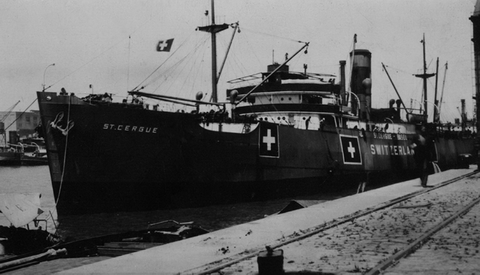
The ST-CERGUE, the first vessel of Suisse-Atlantique
From the day of purchase, the ST-CERGUE was fully taken care of by the office of André & Cie. in Lausanne, further it was endeavoured as far as possible to put Swiss seamen on board. Actually she was the first Swiss ship commanded by a Swiss master, Capt. Fritz Gerber. He took command already when she sailed under Panama flag and served on the vessel during a considerable time during the war. In early May 1940 the vessel arrived in Rotterdam and a few days later was surprised by the German occupation of the Netherlands. Now blocked in the port, it took more than one year to arrange her release through diplomatic channels and to obtain sailing permissions from both war parties. The ST-CERGUE sailed from Rotterdam to New York, where the vessel arrived on 31.07.1941. Already on 10.07.1941 the ship was entered as number 5 into the Swiss registry and after her arrival in New York, the Swiss flag was raised for the first time on 1st August 1941, the Swiss National day. As from now the KTA (war transport office) operated the vessel commercially until of the end of the war.
The first new building and 2nd. vessel of the young shipping company Suisse-Atlantique was delivered in 1948, the GENERAL GUISAN, built in West Hartlepool, England, equipped with an original Sulzer diesel engine from Winterthur. General Henri Guisan personally attended the naming ceremony. With the construction of the GENERAL GUISAN the technical and commercial management was moved to Lausanne.
The GENERAL GUISAN, the first new built vessel for Suisse-Atlantique and the Swiss merchant fleet
In 1952 followed two other new buildings from Great Britain, the oil fired steamer ST-CERGUE (2nd. vessel of this name) and the motor vessel ROMANDIE (later SILS), which already was laid out to burn heavy fuel. In 1951 the three years old steamer LAUSANNE (later LUCENDRO) was purchased and in 1952 the NYON was delivered from a Dutch shipyard.
As from 1956 until 1962 followed the "Yugoslav period", due to a compensation agreement of the Swiss government with Yugoslavia a few ships were built in Yugoslav shipyards, but equipped with original Sulzer diesel engines from Winterthur. A total of 10 ships were delivered from Rijeka and Split, the tween deckers with their beautiful and elegant appearance, as well as the first, small bulk carriers for Suisse-Atlantique, the BREGAGLIA and the BARILOCHE delivered in 1962.
The steamer BRASILIA (built 1943 in Canada) was acquired at an auction in November 1958 for outstanding charter liabilities, but could be disposed of within a few months, in April 1959.
Already in 1959 the company had a fleet of 10 modern freighters, the older units were always sold off in good time, keeping the fleet in good condition. Most ships were ordered directly with the shipbuilders and constructed under own supervision. In exceptional cases, newer and well maintained vessels were purchased on the second-hand market. Since many years the fleet consists of 10 to 14 units, which are renewed constantly, a number which remains manageable for the ship owner and allows for efficient administration. This prudent and forward-looking policy is aimed for and enforced until present days.
After the first Suez crisis in 1956 the shipping market declined. The Transports Maritimes Suisse-Outremer S.A. Geneva (TMSO, telegram address SUISMER) had ongoing charter parties and therefore a need for a tween decker. In April 1957 Suisse-Outremer took over the NYON as manager, unfortunately the ship grounded on 15.11.1958 on the cliffs of St. Abbs Head on the East coast of Scotland. With this accident the management by Suisse-Outremer was terminated. The NYON was cut between bridge and engine room superstructure, the aft part was towed to a Dutch ship repair yard and the forward part demolished on site. A new, elongated fore ship was constructed and fitted to the original aft part of the ship. However the NYON had no luck, already on 15.06.1962 she sank after a collision in the English Channel. Fortunately in both accidents no one was harmed. This remained the only ship's loss in the company's history over more then 70 years. Contrary, the old ST-CERGUE under the command of Captain Gerber was a "lucky ship", saving many survivors during World War II.
In the early 60ties Suisse-Atlantique operated a liner service, using various vessels, such as the CORVIGLIA, the NYON and the SILVAPLANA, called "Suisse-Atlantique Line". These vessels plied between West Germany and the USA, carrying new cars from Germany to USA and on the return voyage coal to Europe. The line lasted for about two years and ended with the sinking of the NYON, taking a full cargo of Porsche and VW cars to the bottom of the sea.
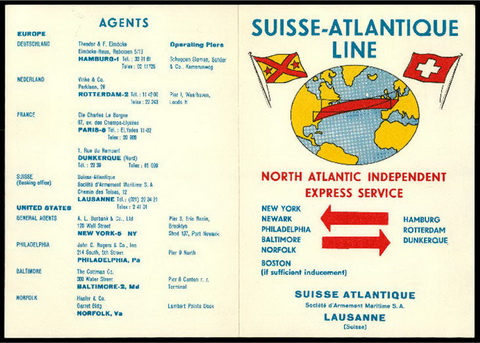
Brochure Suisse-Atlantique Line (Courtesy of Federal Archive, Berne CH-BAR#E2003-08#1977-181#640#36)
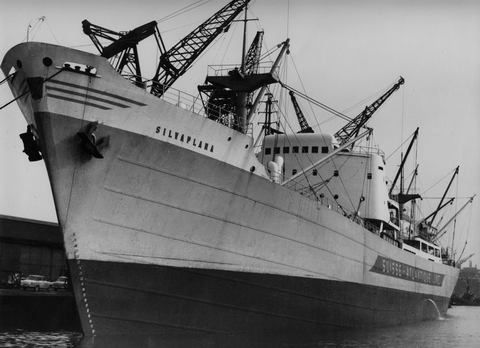
M/V SILVAPLANA of the SUISSE-ATLANTIQUE-LINE
In March 1963 Suisse-Atlantique took a rapid decision, almost over the night, to purchase the three "A-ships", the ANUNCIADA, ALLOBROGIA (sister vessel of the BASILEA) and ARIANA of Suisse-Outremer S.A. in Geneva. Apparently due to the poor international shipping market, the lending bank, Banque Pictet in Geneva, pushed Suisse-Outremer to sell these ships, against the will of Alfred Lüssi, the director of Suisse-Outremer at the time. The ship's crews were taken over with the existing working contracts of Suisse-Outremer. Two of these freighters (ANUNCIADA and ALLOBROGIA) could be sold-off in short time, the ARIANA remained successfully in service until 1966.
In 1965 one of the last European built vessels was delivered from a shipbuilder in Scotland to Suisse-Atlantique, the bulk carrier ROMANDIE (2nd. ship of this name) with 34'000 tonnes DWT the largest ship of the company and by far the largest one in the Swiss merchant fleet. Afterwards ships were ordered from the emerging Far East, first from Japan, then from South Korea. Suisse-Atlantique never contracted any new buildings to the People's Republic of China, however four vessels were built in Taiwan (Republic of China). In 1994/95 two Panamax bulk carriers were delivered by the Burmeister & Wain Shipyard, Copenhagen, the ROMANDIE (4th. ship of this name) and the SILVRETTA (3rd. ship of this name).
The golden age of Japanese ship building lasted until the 1980ties, then South Korea emerged as a new ship building nation. The first building contracts were awarded in 1966 to NKK, Tsurumi Shipyard, Yokohama, Japan for the two Panamax bulk carriers EL PAMPERO and GRISCHUNA (sister vessels of the 1st. generation Panamax bulk carriers of 58'500 dwt of Metrofin Ltd, Zürich, however more modern and better equipped).
With the construction of the Panamax bulk carrier ENGIADINA in 1985, South Korea became supplier of new ships. However, before her delivery the ENGIADINA was resold to another ship owner, but already two years later the GRISCHUNA (2nd. ship of this name) was taken into service from the same shipyard in Ulsan.
As a small remark in between, especially to the older sailors, we found in one of the Bulletin de Liaison (the company's staff magazine), that the vessels of the Suisse-Atlantique fleet remained during 1989 for an average time of 139 days in port (38 % of the year), that means every third day was spent in port.
As a subsidiary company of a large grain trading firm, Suisse-Atlantique for many years operated a fleet consisting first exclusively of tween deckers and later of bulk carriers. In 2000 these activities were extended and container ships (2800 TEU) were ordered in South Korea. In June 2002 the first ship, the ENGIADINA was delivered, followed by further five units of the same type. All these vessels sailed or still are sailing in time charter for large and well known, global container operators.
Currently Suisse-Atlantique has three post-Panamax bulk carriers of about 87'000 tonnes DWT on order from a Korean owned and managed shipyard in Vietnam, to be delivered until 2016. With a beam of 38 m these vessels cannot pass the existing locks of the Panama Canal, but with the inauguration of the new locks scheduled for 2016, passage of the Panama Canal will be allowed with these new generation, larger vessels.
The vessels of the André family usually belong to the owner company Oceana Shipping AG, Chur. Until 2006 another company was owner of many ships, the Helica S.A. Geneva, however it is now merged with Oceana Shipping AG. Ships in partnership with other investors were property of other owner companies.
3. Development of the fleet
In 1939 the first vessel, the ST-CERGUE was purchased, sailing first under the flag of Panama, until the Swiss flag at sea was created in 1941. In February 1948 the second vessel followed, the new building GENERAL GUISAN.
| - From 1939 - 1948 | 1 vessel | - July 1962 | 10 vessels |
| - February 1948 | 2 vessels | - June 1978 | 12 vessels |
| - October 1952 | 5 vessels | - February 1983 | 14 vessels |
| - August 1956 | 7 vessels | - May 1985 | 15 vessels |
| - May 1959 | 10 vessels | - December 1986 | 13 vessels |
| - June 1990 | 11 vessels, of which 10 under Swiss flag | 503'778 tonnes DWT | |
| - August 1995 | 12 vessels, of which 9 under Swiss flag | 723'547 tonnes DWT | |
| - June 1999 | 10 vessels, of which 5 under Swiss flag | 744'566 tonnes DWT | |
| - June 2006 | 10 vessels, of which 9 under Swiss flag | 562'142 tonnes DWT | |
| - Sept. 2010 | 12 vessels, of which 12 under Swiss flag | 577'136 tonnes DWT | |
| - March 2013 | 13 vessels, of which 13 under Swiss flag | 601'810 tonnes DWT | |
| - December 2014 | 15 vessels, of which 15 under Swiss flag | 718'140 tonnes DWT |
4. The Seaman
The first ship, the steamer ST-CERGUE was manned mainly by Italians and Spaniards. During the war also seafarers from Belarus (White Russia) were employed. Later the first Swiss joined. All crewing matters, especially appointing masters and senior officers was at all times decided in the Suisse-Atlantique crewing office in Lausanne.
For the first 30 to 40 years of the shipping company the ship's crews consisted mainly of Italians, Yugoslavs and Swiss. After acquiring the large bulk carriers ST-CERGUE and DIAVOLEZZA (under Swiss Flag), as well as IGUAZU and EL PAMPERO (under Bahamas Flag) in 1991, the first Ukrainians and for a short period some Pakistanis were taken under contract.
When the federal allowances for Swiss nationality seamen were cancelled (paid from 1990 until 1994) and with increased prosperity and the social changes, the seaman's profession in Switzerland lost its prestige, the portion of Swiss seamen on board diminished rapidly, but also Italian seamen disappeared from the vessels.
Today mainly Croats and Ukrainians from Odessa sail on the vessels. Lately, ratings from the Philippines are employed on some ships. Now only a few Swiss are to be found on board.
Many Swiss masters, chief engineers, officers and seamen have sailed in the past 50 years on ships of Suisse-Atlantique, some of them over decades.
Finally we wish to mention one very special and outstanding career with Suisse-Atlantique, made by 2nd. officer Peter Zulauf. He joined his first vessel as a mess boy back in 1958, then worked on deck. After obtaining his mate's license in 1964 in England, all the years he sailed by his own wish as 2nd. mate until his retirement in 2008, all in all 50 years with the same shipping company.
5. The organisation on shore
The office of the shipping company Suisse-Atlantique S.A. was first situated in the head office of André & Cie; in the foundation year the firm was located at Avenue Bellefontaine, Lausanne. After the war the office space soon became too small and in 1948 the family André built its first own office building close to Avenue des Toises, which offered space for approximately 150 to 180 employees. As the activities of André & Cie expanded rapidly during this period, Suisse-Atlantique was moved to a villa at avenue Mon Repos in the vicinity of the head office.
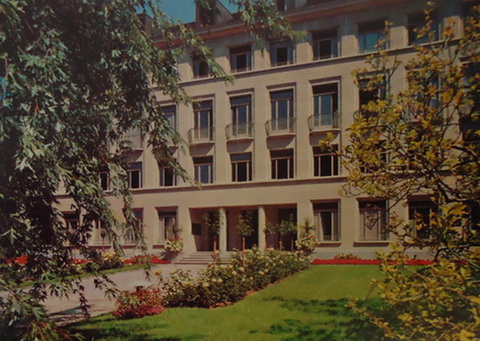
The office building at Avenue des Toises (courtesy of Suisse-Atlantique)
In March 1962 all offices were moved to the new office building at Chemin Messidor 7, Lausanne, remaining head office of André & Cie until the closure of the trading company in 2001, then In March 1962 all offices were moved to the new office building at Chemin Messidor 7, Lausanne, remaining head office of André & Cie until the closure of the trading company in 2001, then Suisse-Atlantique had to move out. A new home was found in a modern office building at Avenue des Baumettes 7, above the city centre of Renens VD, which was taken over on 19.09.2001.
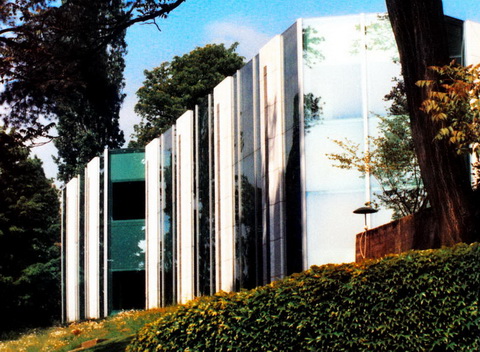
The office building at Chemin Messidor 7, Lausanne (courtesy of Suisse-Atlantique)
In April 1985 the company's name was changed to Suisse-Atlantique Société de Navigation Maritime S.A. The telegram address changed from SUISARM to SUISAT.
The funnel mark of Suisse-Atlantique displayed on a grey funnel, shows the red St. Andrews cross with two red stars on a yellow background, the crest of the André family. July 1998 marked a special occasion in the history of the company, when the ISM-code became mandatory in international shipping (ISM = International Safety Management). To commemorate this event with its linked obligation for enhanced safety and performance and to demonstrate it in an appropriate way to the public, the grey funnels were changed to blue colour and five yellow stars added above the St. Andrews cross. At that time the André family was also majority share holder of the airline company Farnair in Basel (now sold off), creating a uniform logo for the family's business interests (the airplanes of Farnair carry as company logo five yellow stars on a blue ground on their tail fins).
The personnel department for many years was led by Charles Honegger until his retirement end of 1988, when he was relieved by his assistant Kurt Buergin. Since August 2009 David Martinez, a former employee of Acomarit and V.Ships, looks after the ship's crews.
The subsidiary company SAROC SpA, Genoa was opened already in 1936 by André & Cie, later this office looked also after the interests of Suisse-Atlantique, mainly to hire Italian and Croatian seamen. In 1965 SAROC was moved to Milano and the office in Genoa continued to work exclusively for Suisse-Atlantique. For many years the office was located at Largo Zecca near the entrance to the Garibaldi road tunnel, opposite of hotel Helvetia at Piazza Nunziata (in the hotel Helvetia was also the famous Ristaurante Tirolo, well known to all Swiss seamen of Keller Shipping). In 1998 the office was moved to the other end of the tunnel, to Via Interiano 3-5d, but was closed down in 2002.
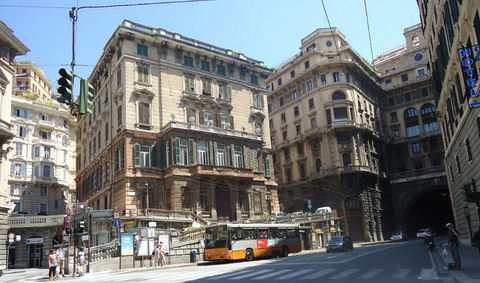
The Genoa office was for many years in this building, opposite hotel Helvetia
As from 2002 space was rented in the office of V.Ships Croatia, situated in a prime location at the harbour of Rijeka, Croatia to facilitate the hiring of Croatian seafarers.
Apart from the personnel department, the technical department is the most important division, as it determines to a large extent the life of the seafarers on board. This office was first led by Eng. Georg Maier. Being an engineer, he worked before in the technical department of André & Cie, representing Swiss companies overseas. As from 1956 his successor was Dr. Eng. Ernest Krauss, who had joined the Company as superintendent in 1952 for the construction of the ST-CERGUE in England. He was responsible for the Yugoslav built ships, later the ROMANDIE (2nd. vessel of this name) in Glasgow, as well as various new constructions in Japan. After his sudden death in 1982 Eric André took over, who was later relieved by Chief Engineer Rudolf Zoellig, who supervised planning, building supervisions and the technical management of the fleet with great success until his retirement in 2006. Rudolf Zoellig initiated also the construction of the container ships. From 2006 until 2014 Chief-Engineer Alfred Jaeggi was the director of the technical department. Since September 2014 Jean-Noel André (1973, 6th. generation) leads this department.
The commercial side of the company was successfully taken care of by director Willy Fierz from 1952 until 1980, while Georges A. André personally led and supervised the whole company. The chartering division, which placed the owned ships on the international shipping market, worked also very prosperous under Georges Rouge and later with Georges Taillard. Today the team of Philippe Ziehli and Patrick Gentizon are responsible for the chartering.
As a final comment, in the early days the French language was used in the office, but also in the communication with the vessels. In these days the Swiss and Italian masters and chief engineers were able to understand the French language. The changes brought in the past, with Croatian and Ukrainian crews, but also with the arrival of many nationalities in the office, necessitated the adaption of the English language for communication within the office and with the ships.
We wish to thank Mr. Eric André and Mr. Kurt Bürgin for their valuable advice and assistance to create this company history.
*) The CALANDA was owned by Schweizerische Reederei AG, Basel (Swiss Shipping Co.) and the 75th. anniversary will be celebrated next year on 19.04.2016 in the port of Basel.
Sources:
- Bulletin de Liaison (company magazine)
- Historical dictionary of Switzerland
- Swiss federal archive, Bern
- Various news paper articles
SwissShips HPS, October 2015